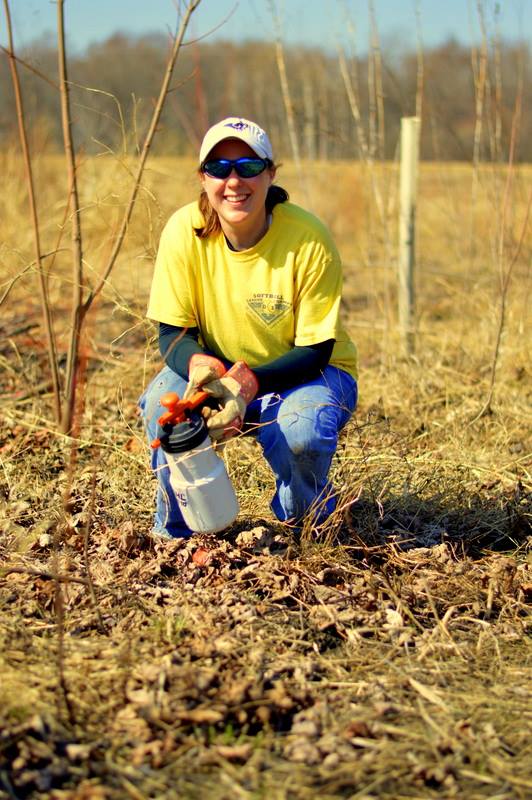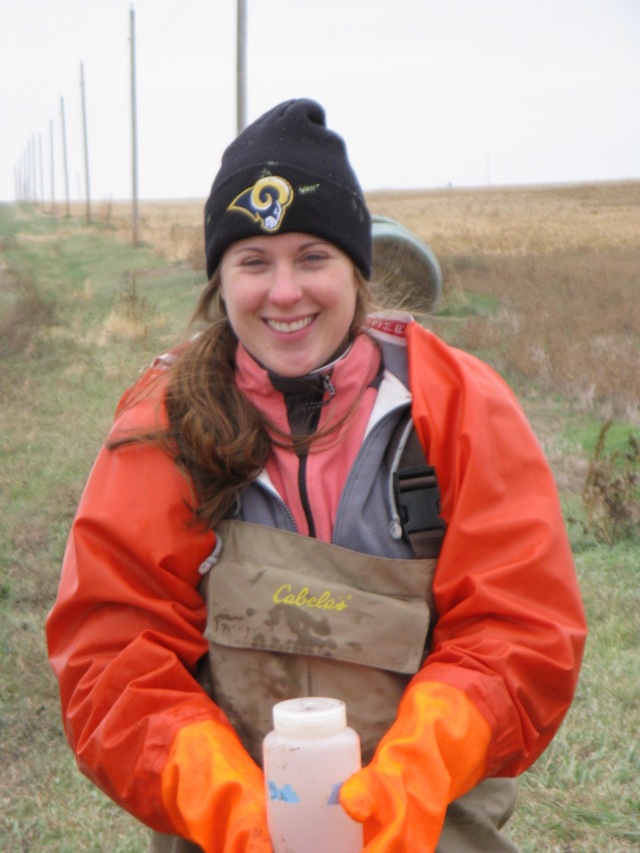
This latest blog post features a question and answer session with Krista Kirkham, an Assistant Aquatic Ecologist with The Nature Conservancy, who, as you can tell by this photograph, feels right at home in wetlands.
The growing season is here. It’s an exciting time, but the fields of green bring with them some issues. Nutrient pollution and erosion of our precious soil are two big problems.
Nitrogen and phosphorous from fertilizers wash into tile systems and end up in our streams, lakes, rivers and, eventually, our ocean, creating the Gulf of Mexico Dead Zone. As of August 1, 2014, this Dead Zone covered an area of 5,052 square miles,1 and has so little oxygen, the water cannot support life.
Not only do these nutrients cause problems in the Gulf of Mexico, but they also lead to toxic algae blooms and cause negative effects on our native plants and animals. Some researchers are working hard to find ways to decrease or prevent this nutrient runoff. One of them is Krista Kirkham, an Assistant Aquatic Ecologist with The Nature Conservancy. She is researching the effectiveness of conservation practices in agriculture to improve water quality and biodiversity in the Midwest’s freshwater.
- What is the goal of your research? What question or problem do you hope to answer or solve?
Our research goals are to determine how effective various agricultural best management practices are at improving water quality and habitat in agricultural watersheds. We are involved in three different projects in the upper Mackinaw River watershed that address this issue at the farm scale (250 acres), small sub-watershed scale (10,000 acres),and larger sub-watershed scale (26-40,000 acres) that serves as a drinking water source for ~80,000 people. We are primarily focused on the effectiveness of constructed wetlands at reducing nutrients, specifically nitrogen and phosphorus, from agricultural tile-drained waters.
- How did you become interested in this topic?
The Nature Conservancy has a commitment to preserve and protect natural places that support high biodiversity. The Mackinaw River is one of the higher quality rivers in Illinois for species diversity and habitat, containing 60-70 fish species and 20-30 mussel species, despite pressures from agriculture and urban areas. The Nature Conservancy began working in the Mackinaw River watershed in the mid-1990s in a collaborative effort to create a management plan for the river. Since then, we have pursued projects in smaller headwater streams to determine the effectiveness of agricultural conservation practices at a measurable scale.
- What are your results so far?
In the first phase of our small sub-watershed project (1999-2007), we were monitoring the effectiveness of three traditional agricultural conservation practices (grassed waterways, strip tillage, and filter strips) in improving water quality through intensive monitoring, along with assessing the effectiveness of focused outreach in the implementation of these practices. We found this type of personal, one-on-one outreach to be important for the implementation of these practices, but unfortunately we found no improvement in water quality. We learned that in this type of agricultural drainage system, conservation practices need to focus more on the inputs from tile drainage water rather than from surface water runoff. This lead to a second phase, where we are now working with landowners to construct wetlands that are specifically built to capture and retain tile drainage water before it flows into the adjacent stream. These wetlands are cost-shared through the Farm Bill Conservation Reserve Program (CRP) practice 39, or Farmable Wetlands Program.
We have learned that these constructed wetlands can be effective at removing nutrients. Our wetland project on a working farm in Lexington, Illinois has shown that wetlands representing 2.5-5% of the drainage area can reduce nitrogen concentrations up to 40%. Knowing that a small wetland can lead to significant reduction in nutrients is quite promising not only for water quality, but also for their adoption by landowners and farmers.
- Where is your research heading in the future and what obstacles, if any, do you have to overcome?
Currently, we are working on implementing more wetlands throughout our Mackinaw research sub-watersheds and monitoring their effectiveness of reducing nutrients. This involves quite a bit of outreach and partnership with area agricultural agencies, which we are fortunate to have in McLean County, IL. We are also beginning to incorporate cover crops and other conservation practices that show promise for nutrient retention.
Since we are working with landowners on private ground, there are always challenges with implementing voluntary conservation practices at scale; these practices have to fit in to a producer’s farming operation, so finances, maintenance, and long-term benefits are all important factors a producer considers before committing to a practice that may take just a minimal amount of land out of production. One of our biggest obstacles initially was the lack of a Farm Bill in 2012; it was very difficult to work with producers to sign up for these programs when there was no funding available or USDA staff to assist them. In addition, wetlands are a new practice in this area, and most producers are unfamiliar with their benefits or how they would fit into their current farming system. However, now that a few wetlands have been installed in these watersheds, we are working hard to continue our outreach and monitoring efforts, along with offering technical and financial support to landowners or farmers who sign-up for the Farmable Wetlands Program.
- Is there any other information you would like people to know about your research?
We have published 2 papers and a technical report on our work.
I hope you have enjoyed our second guest post. Her work is truly fascinating, and it shows that there is hope to fix our water problems and preserve our precious resources for the next generation. If you would like read about this incredible research, please see the attached papers. If this post has inspired you to help keep our waters clean, check out the Illinois River Watch Network at http://www.ngrrec.org/riverwatch or contact Matt Young, the River Watch Coordinator at (618)468-2784 at the National Great Rivers Research and Education Center (NGRREC). If you are interested in The Nature Conservancy, please check out their website at http://www.nature.org.
Information Sources
- “Northern Gulf of Mexico Hypoxic Zone.” Mississippi River Gulf of Mexico Watershed Nutrient Task Force. Web 28 April. 2015. <http://water.epa.gov/type/watersheds/named/msbasin/zone.cfm>.
- Outreach and the adoption of conservation practices by farmers
- Effects of outreach on the awareness and adoption of conservation practices by farmers in two agricultural watersheds of the Mackinaw River, Illinois
- Evaluating Agricultural Best Management Practices in Tile-Drained Subwatersheds of the Mackinaw River, Illinois





